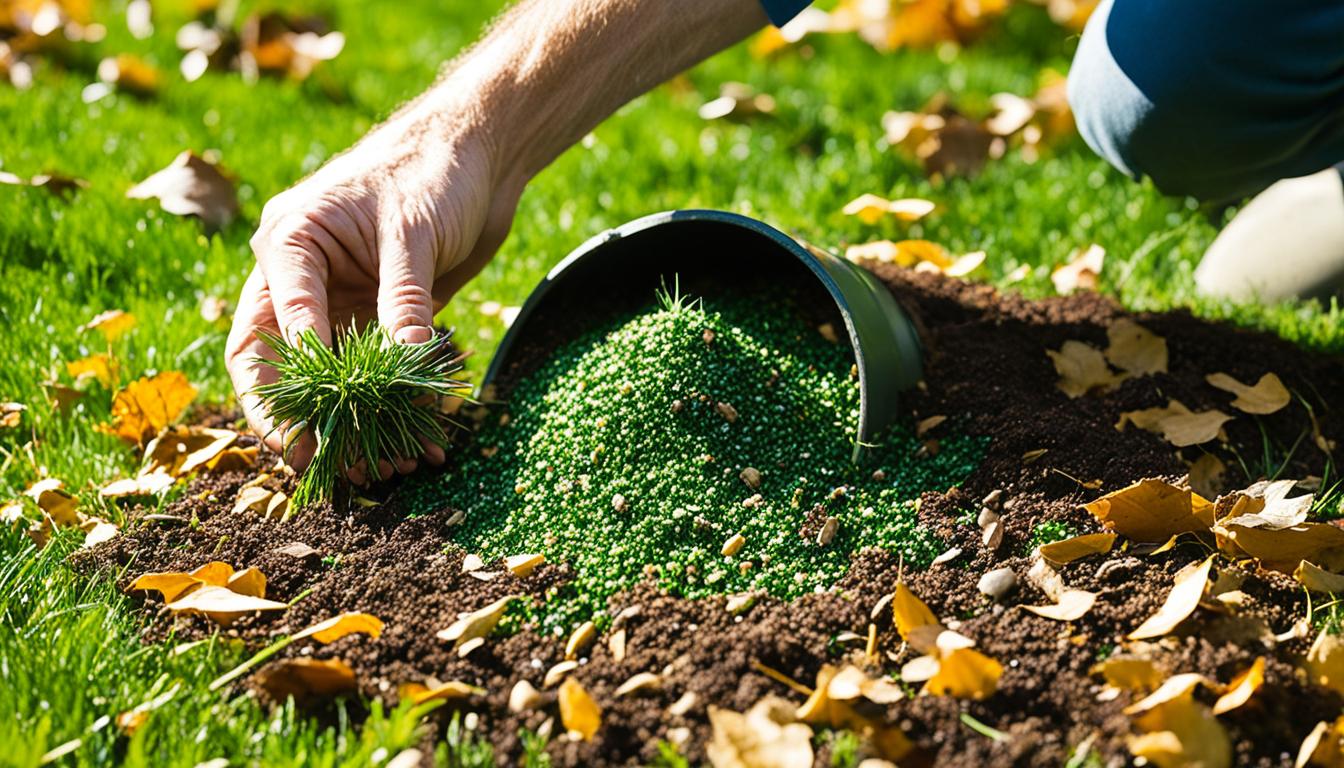As summer ends and autumn begins, it’s a great time to plant grass seed in your lawn. Timing is key for fall grass seeding. You want the seed to germinate before winter hits. Also, wait after using weed controls as the product label suggests.
By following a simple process, from picking top-notch grass seed to watering and caring for it, you can get a lush, green lawn come spring. I’ll walk you through the key steps to plant grass seed in the fall. This way, you’ll have a beautiful, healthy lawn ready for the cooler months.
Identify Your Grass Type
Cool-Season Grasses
Before you start your fall grass seeding, you need to know what type of grass you have. Cool-season grasses are common in the northern U.S. They do well in hot summers and cold winters.
Kentucky bluegrass, perennial rye grass, and tall or fine fescue are popular cool-season grasses. Kentucky bluegrass has a deep green color and great texture. Perennial ryegrass grows fast. Tall fescue, like Kentucky 31, is tough and affordable. Fine fescue is great for shady spots.
Cool-season lawns need special care. Use high-nitrogen fertilizer in fall and spring. Overseeding in fall helps prevent bare spots in spring.

“Approximately a dozen different grass types are commonly found in lawns, with most lawns containing a mixture of different grasses.”
Test and Prepare Your Soil
Starting a lush, healthy lawn begins with caring for your soil. Testing your soil regularly helps you understand what your lawn needs for the best growth. If it’s been 3-4 years since your last test, it’s time to check again.
You can test your soil with a DIY kit or by reaching out to your local Cooperative Extension Service. These tests show your soil’s pH level, which is key for grass health. Most cool-season grasses prefer a pH between 6.5 and 7.0. If your soil is off this range, you can fix it with limestone or sulfur.
| Soil Amendment | Effect on Soil pH | Application Rate |
|---|---|---|
| Calcitic Limestone | Raises pH | 2-4 lbs per 100 sq ft |
| Dolomitic Limestone | Raises pH | 2-4 lbs per 100 sq ft |
| Elemental Sulfur | Lowers pH | 0.5-1 lb per 100 sq ft |
| Wood Ash | Raises pH | 2-4 lbs per 100 sq ft |
Adjusting the pH is just the start. You also need to loosen compacted spots, clear out debris, and break up clods. Adding compost can make your soil better at holding water, draining well, and supporting roots. It’s great for both clay and sandy soils.
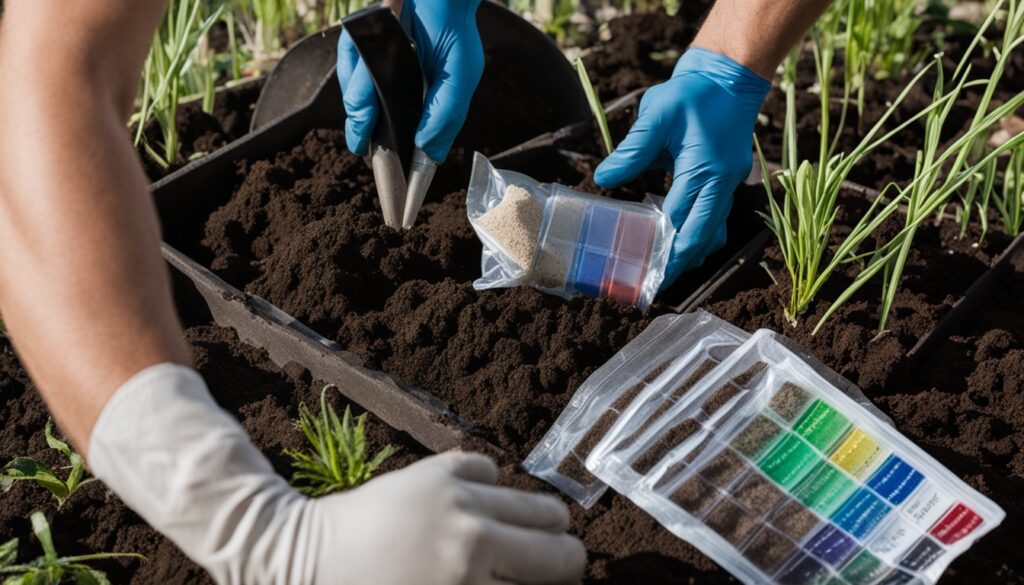
Testing and amending your soil lays the groundwork for healthy grass. Taking the time to prepare your soil well will help your lawn succeed over the long term.
Fix Bare Spots
Keeping your lawn green and full can be tough. Things like insects, drought, fungi, or flooding can cause bare spots. It’s important to fix these quickly to get your lawn looking great again.
To start, remove dead grass or weeds from the bare spots. Then, turn the soil over and add a lot of compost. This makes the soil rich and gives new grass the nutrients it needs.
You have two ways to repair lawn bare spots. You can spread grass seed over the area and cover it with soil and fertilizer. Or, you can take healthy grass from another part of your yard and move it to the bare spot. Press it down well.
| Grass Seed Patching | Sod Patching |
|---|---|
| Takes about 20 minutes to seed initially | Sod patches can develop a shallow root system in 2 weeks, deep roots in 6 weeks |
| Grass seed patches require light daily watering, additional protection in hot weather | Sod patches can blend in with the surrounding grass within a couple of weeks |
| Grass seed patches take up to 6 months to fully integrate into the lawn | Sod patches don’t require fertilizing until well-established |
Choosing how to fix lawn bare spots matters. Make sure to deal with any pests or weeds to help the new grass grow well. With the right steps, you can turn those bare spots into a lush lawn.
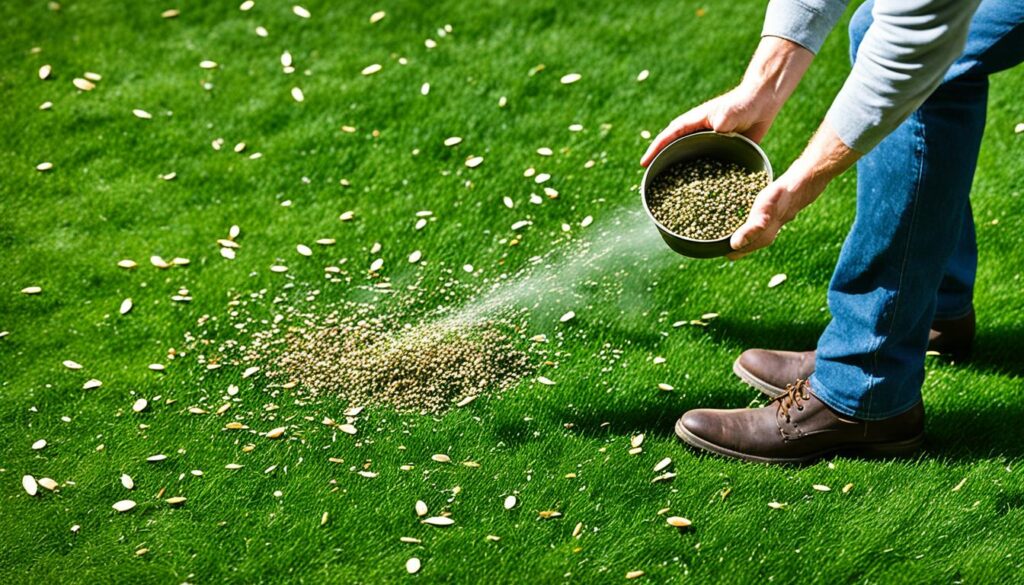
“Throwing grass seed on bare spots without proper preparation will result in minimal to no germination, which will not effectively repair lawn spots.”
How to plant grass seed in the fall?
Overseeding Technique
Overseeding is a great way to make your lawn thicker in the fall. Use a broadcast spreader for big areas or a drop spreader for small ones. Make sure your lawn is dry before you start. Then, go back and forth in one direction with your spreader.
For even coverage, make another pass at right angles to the first one. This ensures your lawn gets an even layer of seeds.
To figure out how much seed and fertilizer you need, measure your lawn’s size. The National Turf Evaluation Program suggests planting about 16 seeds per square inch for the best growth. Spread the seed and a starter fertilizer, like GreenView Fairway Formula Seeding Success, on the same day for the best results.
- Use a broadcast spreader for large areas or a drop spreader for smaller spaces.
- Make passes back and forth in a single direction, then make a second round of passes perpendicular to the first.
- Measure your lawn to determine the square footage and apply the recommended 16 seeds per square inch.
- Apply the grass seed and a starter fertilizer on the same day.
Overseeding your lawn in the fall helps thicken it and gets it ready for a healthy look next season.
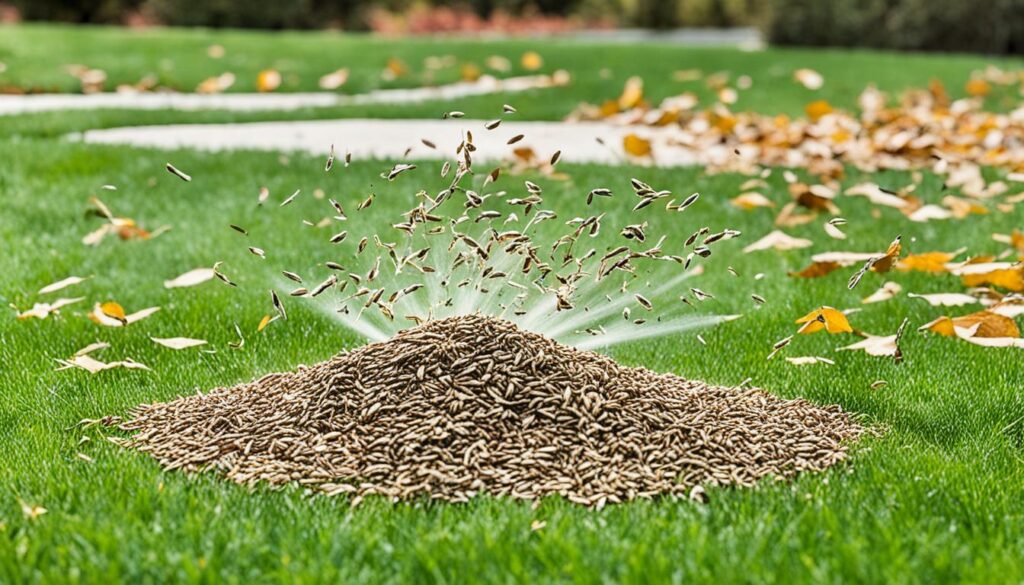
“Optimal root growth is encouraged when planting grass seed in the autumn. The best time to plant grass seed in fall is when nighttime temperatures drop to about 60 degrees F.”
Weed and Feed
Keeping your lawn green and weed-free is a delicate task. Using a weed and feed product can help you do both at once. This is especially useful as the seasons change.
For cool-season grasses, the best time to fertilize is late summer or early fall. This gives your grass the nutrients it needs to recover from the heat. It also strengthens the roots, making your lawn healthier and more resilient.
If you only have a few weeds, you might be able to remove them by hand. But to really stop weeds from growing, you need a thick, healthy lawn. Using a weed and feed product that also includes grass seed can help you achieve this.
When picking a weed and feed product, always read the label and follow the instructions. These products often have herbicides like 2,4-D to kill weeds. They also have fertilizer to make your lawn green and healthy.
To get the best results, apply weed and feed when the grass is damp, in the late afternoon or early evening. Make sure to mow your lawn a few days before applying it. And don’t put too much on to avoid harming your grass.
Using a weed and feed product at the right time can make your lawn look great and keep weeds away. With the right product and some care, you can have a beautiful lawn your family will love.
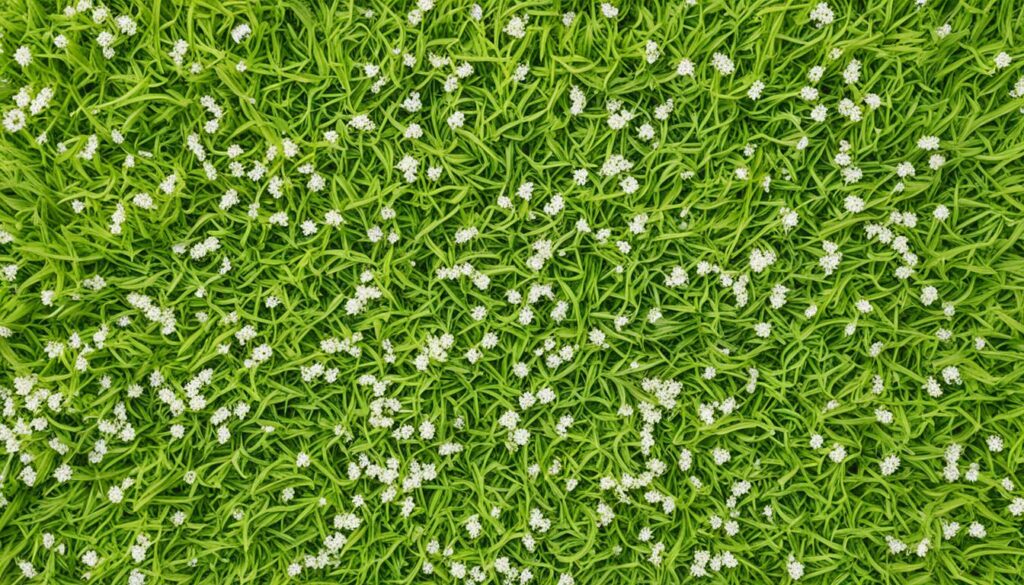
Not all weed and feed products are the same. Some, like those with 2,4-D, can be bad for plants or the environment. Look for products without 2,4-D, like those with Confront. Always follow the instructions and don’t use too much to protect your lawn.
Lawn fertilization and weed control are key to a healthy lawn. By balancing these, you can have a beautiful outdoor space for years.
Watering and Maintenance
Keeping your grass healthy and lush all year requires proper watering and maintenance. After planting your new grass seed, it’s key to keep the soil moist until the grass is 2 inches tall. Water lightly but often, about 3-4 times a day, to stop the soil from drying out.
Once the grass is established, switch to deeper, less frequent watering. Aim for about 1 inch of water per week. This helps the roots grow deeper into the soil, making your lawn more resistant to drought. Always watch the weather and adjust your watering plan as needed.
Tips for a Healthy Lawn
- Mulch fallen leaves to add nutrients to your lawn and prevent the grass from being smothered.
- Mow your lawn at the right height, usually 3-4 inches for cool-season grasses. This keeps your lawn looking good and helps the roots grow deep.
- Aerate your lawn now and then, especially in the fall. This improves how well water and nutrients get into the soil and reduces soil compaction.
By following these easy lawn care tips, your newly seeded grass will flourish. Your lawn will stay lush and green all year. A bit of care and attention makes a big difference in keeping your outdoor space looking great.
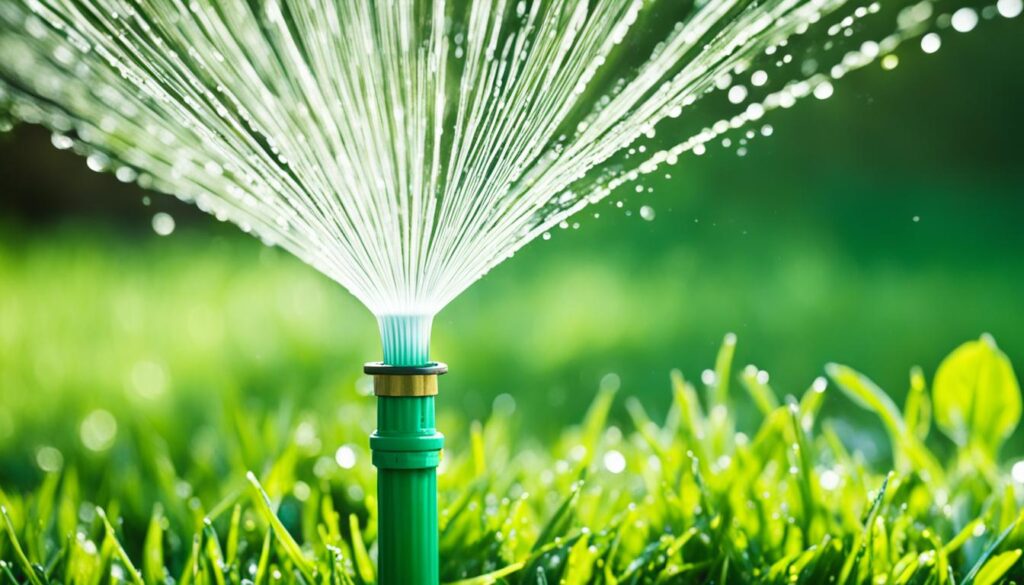
Choosing the Right Grass Seed
Finding the right grass seed is key to a lush, healthy lawn. Look for seeds tested by the National Turf Evaluation Program (NTEP). These seeds are chosen for their vibrant green color, resistance to disease and insects, and ability to withstand drought.
Choose a grass type that fits your climate well. Cool-season grasses do great in northern areas with mild summers and cool seasons. Warm-season grasses are best for the hot, humid south.
If you’re adding new seed to an old lawn, pick a type that matches what you already have. This makes your lawn look uniform and well put together.
“Pennington Smart Seed products are designed to provide the perfect grass seed for your region and lawn conditions.”
Think about what your lawn needs when picking grass seed. Consider how much sun it gets, how much traffic it has, and if it’s prone to drought. Pennington has many NTEP-rated grass seed blends for different conditions. This way, you can find the best fit for your yard.
Conclusion
Planting grass seed in the fall is a great way to get a lush, healthy lawn for spring. By picking the right grass type, like cool-season fescue, and preparing the soil well, you’re setting up for success.
Using overseeding and fixing bare spots, and keeping up with watering, mowing, and weed control, helps your lawn grow well. Following the best practices for fall grass seeding and lawn care is key to a green lawn all year.
With over 20 years of experience in Nashville, I know fall is the best time for grass seed growth. Taking the time to plant and care for your lawn leads to a lush, healthy, and easy-to-maintain outdoor area.
FAQ
When is the best time to plant grass seed in the fall?
Planting grass seed in the fall should be timed to let the seed germinate before freezing temperatures. Also, wait after applying weed controls as the product label suggests.
What type of grasses are considered cool-season?
Cool-season grasses include Kentucky bluegrass, perennial ryegrass, and tall or fine fescue. These are great for areas with hot summers and cold winters. They need fertilizer in fall and spring, and overseeding in fall helps prevent early spring bald spots.
How do I prepare the soil for grass seeding?
Start with a soil test to pick the right fertilizer and seed for a healthy lawn. Loosen the soil, remove debris, and break up clumps. Adding compost helps with drainage in clay soils and water retention in sandy soils.
How do I fix bare spots in my lawn?
First, remove dead grass and weeds. Then, turn the soil and add compost. You can either scatter grass seed and cover it or transplant a healthy patch of grass into the bare area, pressing it down well.
How do I overseed my lawn in the fall?
Use a broadcast spreader for big areas or a drop spreader for small ones. Start with a dry lawn and spread the seed in one direction, then another at right angles for even coverage. Seed and fertilizer on the same day for best results.
How do I control weeds and feed my cool-season lawn?
Fertilize your yard in late summer or early fall for the nutrients your grass needs. For a few weeds, pull them by hand. Or, use a weed and seed product for easy weed control and seeding.
How should I water and maintain my newly seeded lawn?
Keep the seed bed moist until the new grass is 2 inches tall. Then, switch to less frequent, deeper watering. Other tips include mulching leaves, mowing right, and aerating the lawn now and then.
What should I look for when selecting grass seed?
Choose NTEP-rated grass seeds for their green color, disease resistance, and drought tolerance. Pick a grass type that fits your climate – cool-season for northern areas, and warm-season for southern ones.
